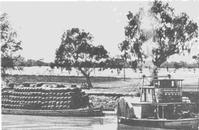


Chapter 7
I The First 100 Years 1788-1888
II Railways
III Motorised Vehicles
IV Aviation
V Modern Shipping
VI Innovative Small Craft
VII Conclusion
VIII Acknowledgements
IX Contributors
References
Index
Search
Help
Contact us

As on the north coast of New South Wales, the rivers were often difficult to navigate. The Murray was the most reliable, and was usually navigable, if only for vessels of a light draught, from Echuca right down to the South Australian port. The Murrumbidgee was less certain; fed by the melting snows of the southern Alps, it was fortunately at its height just after shearing. If, however, the rains in the Alps had been light, the paddle steamers might only have 3-4 weeks (instead of 3-4 months) when the river was safe to travel. The Darling was very erratic; its flow depended upon rains that fell in southern Queensland and northern New South Wales. Thus it could be a fine river with 25-30 feet of water, as it was in 1870-1871, or it could be a mere chain of waterholes as happened in 1885-1886[33] when seven ships, which had started up stream for Bourke, spent fifteen months in the mud waiting for the next rise to release them.
The inadequate depth of the rivers presented a variety of problems for the paddle steamers, and dictated their shape and form. Low water, overhanging trees, sandbars, driftwood, hidden snags, dangerous currents and sudden shallows were everyday hazards. Precautions were devised to minimise such dangers; for example, snags were painted with whitewash so as to be easily seen, and a steamer named The Grappler was launched in 1858 specifically for snagging. The steamers themselves were designed to cope with these conditions. Thus the boats were flat bottomed, or nearly so, and were only four or five feet in draught. This shallow draught was not a new invention, but a piece of imported technology learned from the experience of the river boats on the Mississippi River in the U.S.A. Nevertheless, in order to navigate in exceptionally shallow waters, the South Australian steamers incorporated a uniquely shallow draught.
Most of the steamers were built on the Murray at Goolwa, Mannum, Morgan or Echuca, from local timber, especially red gum. They usually had two or more decks, and ranged in length up to 120 feet and in weight up to about 250 tons.[34] They were fuelled by wood cut from the banks of the rivers, and propelled by paddles, either at the rear or at the side (See Fig. 1). The carrying capacity of the boat was increased by towing barges, which were sometimes lashed to the side of the ship or, more commonly, towed behind. These were loaded with cargoes, predominately of wool, but also of sheepskins, hides, tallow, station supplies, timber and farming equipment.

Some vessels were a little unorthodox, and demonstrated a tendency to make do with whatever was available. William Randell, for example, built his second steamer Gemini by adding a second hull to his old boat The Mary Anne. The new hull was positioned parallel to the old and joined to it by beams and decking, leaving space for a paddlewheel between the two. The boiler was on one half and the engine on the other. This doubled hulled adaption was often difficult to handle, but provided Randell with greater carrying capacity.[35]
People in Bright Sparcs - Inglis, Andrea; Randell, William
 |
Australian Academy of Technological Sciences and Engineering |  |
© 1988 Print Edition pages 450 - 451, Online Edition 2000
Published by Australian Science and Technology Heritage Centre, using the Web Academic Resource Publisher
http://www.austehc.unimelb.edu.au/tia/439.html